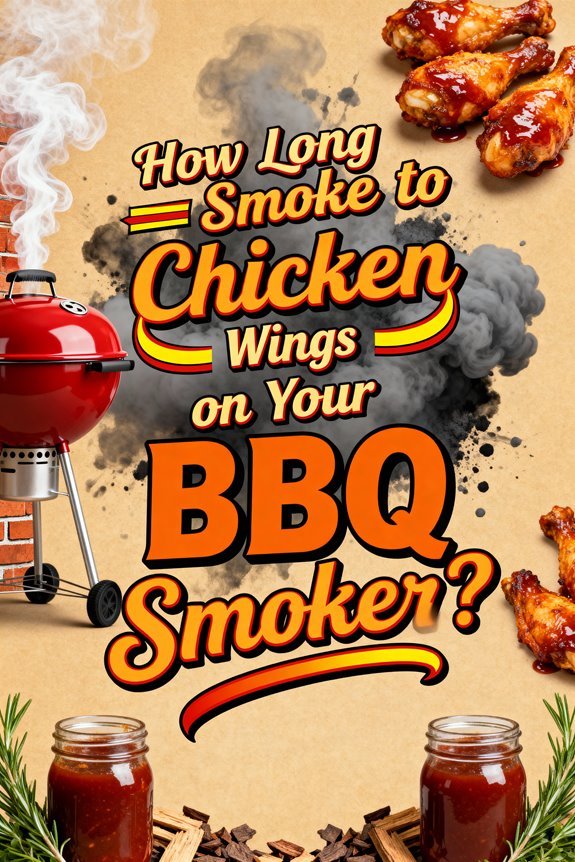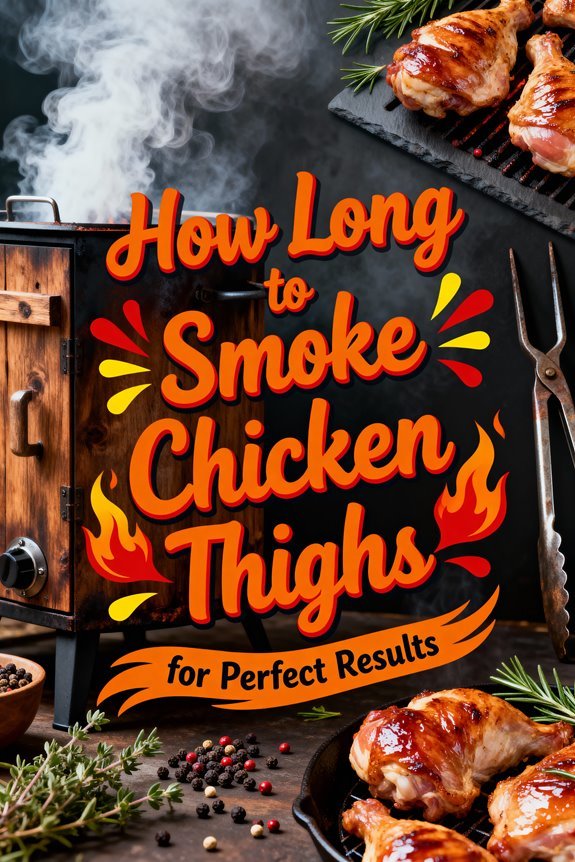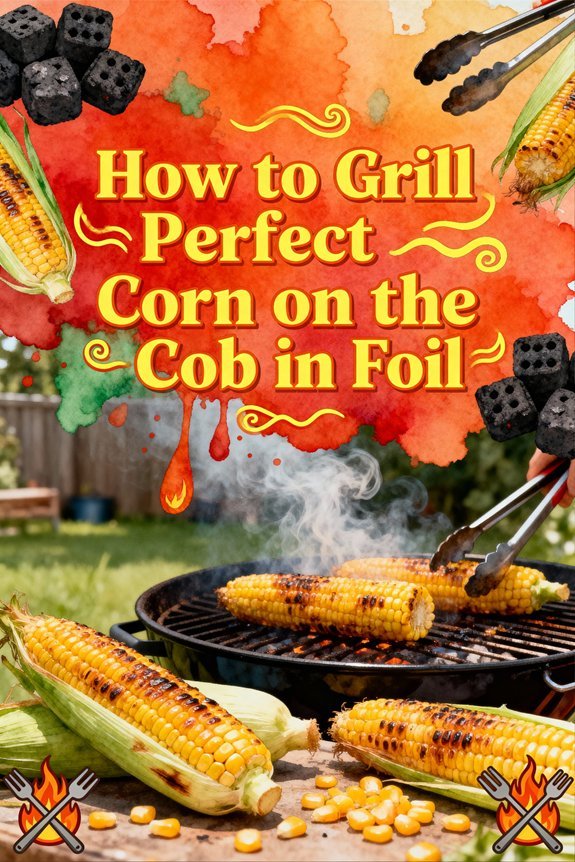You’ll want to smoke chicken wings at 225–275°F for 60–90 minutes, depending on your target temperature and wing size. Lower temps around 225°F require the full 90 minutes for tender meat, while cooking at 275–300°F cuts that time by 15–20 minutes. Always check for an internal temperature of 165–175°F using a digital thermometer inserted into the thickest part. For crispy skin, you’ll need a high-heat finishing step. Below, we’ll cover everything from prep techniques to troubleshooting common pitfalls.
Understanding the Ideal Temperature Range for Smoking Chicken Wings
The foundation of perfectly smoked chicken wings starts with selecting the right temperature range, and most experienced pitmasters land between 225–275°F for good reason. Lower temps around 225°F deliver tender meat with mild smoke penetration, though you’ll sacrifice crispy skin. Bumping up to 250–275°F renders fat more effectively while maintaining excellent smoke absorption—a sweet spot for balanced results. These smoking techniques directly impact your flavor profiles: chicken absorbs smoke quickly, so you don’t need extended low-temp sessions that risk bitterness. Higher temperatures around 275–300°F still impart quality smoke character while crisping skin better. Wood selection matters too—mild varieties like apple or cherry complement wings at standard temps, while stronger woods can overwhelm. Using a metal smoker box helps maintain consistent smoke levels throughout the cooking process. Choose your temperature based on whether you’re prioritizing texture or smoke depth. Keep your smoker at 225°F maximum to prevent the wings from drying out during the cooking process. For food safety, always ensure wings reach an internal temp 165°F before serving.
Total Cooking Time: What to Expect When Smoking Wings
When you load your wings onto the smoker, plan for a 60–90 minute cooking window at standard temperatures—though this baseline shifts based on your heat setting and how you’ve prepped the meat. At 225–250°F, expect the full 90 minutes for proper smoke penetration and tenderness. If you’re running at 275–300°F, you’ll shave 15–20 minutes off that total cooking duration. Wing size directly impacts time variations—larger pieces need the upper end of that range. Use a probe to track internal temperature rather than relying solely on the clock. You’re targeting 165°F minimum, though 175°F delivers better texture. For fruit woods like cherry or apple, expect a lighter smoky profile that won’t overpower the natural chicken flavor. Different smoker models (Traeger, Bradley) may require slight adjustments to these benchmarks based on their heat distribution patterns. Oak and pecan woods provide an excellent flavor balance for smoked poultry. After reaching your target temperature, letting meat rest for 5-10 minutes helps redistribute the juices throughout the wings.
Preparing Your Wings: Marinating and Dry Rub Techniques
Flavor development starts well before your wings hit the grate—your prep choices determine whether you’re serving memorable smoked wings or forgettable ones. While brining methods can enhance moisture retention through several hours of soaking in salt-sugar solutions, they’re optional for wings with adequate fat content. Much like hot smoked salmon, proper temperature control helps ensure even cooking and ideal texture throughout. Dry rubs deliver more concentrated flavor infusion—apply paprika, garlic powder, cumin, and brown sugar directly to the meat, massaging thoroughly into every crevice. You’ll achieve best results by applying rubs 2-4 hours before smoking, allowing spices to penetrate the surface. For maximum impact, layer your techniques: a brief marinade in hot sauce or Italian dressing followed by a generous dry rub creates complex flavor profiles that smoke amplifies beautifully during the cook. Glazes provide a sticky layer of flavor when brushed on during the final stages of cooking, creating an attractive finish on your wings. Like perfectly smoked burgers at 350 degrees Fahrenheit, maintaining consistent temperature control is crucial for achieving ideal results.
Setting Up Your Smoker and Choosing the Right Wood
Your preparation work means nothing if your smoker isn’t dialed in correctly—temperature control and wood selection separate amateur cooks from backyard pit masters. Start your smoker setup by preheating to 225°F-250°F, using a digital thermometer to verify accuracy. Position wood chips strategically and adjust vents for ideal airflow—too much smoke creates bitterness, too little won’t penetrate the meat. Similar to smoking turkey breast, temperature monitoring accuracy is crucial for achieving perfectly cooked meat. For optimal tenderness and safety, cook until wings reach internal temperature 165F.
For wood selection, fruit woods like apple and cherry deliver mild, sweet notes that won’t overpower chicken. Oak provides balanced smoke, while pecan adds richness. Avoid heavy-handed hickory or mesquite unless you’re blending them with lighter woods. The cherry-apple combination consistently produces restaurant-quality results. Look for blue smoke as an indicator that your wood is burning at the optimal temperature for flavor development. Monitor wood consumption throughout the smoke to maintain steady flavor development without overwhelming your wings.
Step-by-Step Smoking Process for Perfect Wings
Proper wing preparation starts the moment you pull them from the refrigerator—moisture is your enemy when you’re chasing smoke penetration and crispy skin. Pat each wing thoroughly dry, then apply your rub or marinade in a sealed container for 12-24 hours maximum flavor infusion. Before smoking, coat wings lightly with oil to promote adhesion and browning. Much like dry brining enhances turkey breast flavor, this pre-smoking preparation ensures your wings develop deep, rich flavors.
Similar to turkey smoking, steady temperature control is crucial for achieving optimal flavor and moisture retention in wings. Arrange wings in a single layer with breathing room between pieces—crowding restricts smoke circulation and creates uneven results. Set your smoker between 225°F and 275°F using indirect heat. Insert your thermometer into the thickest part of several wings. You’re targeting 160°F internally, then finishing to 165-175°F depending on your texture preference. These smoking techniques take 60-90 minutes at steady temps. For maximum crispiness, dust the dried wings with baking powder and salt before placing them in the smoker. Apply sauce only during the final 20-30 minutes to prevent burning.
Achieving Crispy Skin: High Heat Finishing Methods
While smoking delivers exceptional flavor, crispy skin demands a deliberate high-heat finish that transforms rubbery exterior into a satisfying crunch. After smoking wings to 160-165°F at low temps, you’ll need to crank your heat to 375-475°F for the final sear. This high heat step takes just 3-10 minutes, flipping frequently to prevent burning while achieving even crispness. Similar to achieving perfect grill marks on asparagus, consistent rolling and even heat distribution are crucial for the best results.
You’ve got multiple finishing options: raise your smoker to 375°F and sear 5 minutes per side, transfer to a 425°F oven, or deep-fry at 375°F for 3 minutes. For best results, pat wings completely dry before cooking and consider adding baking powder to your rub—it draws moisture from skin, promoting superior crispy skin texture during that vital high-heat finish. If your wings aren’t achieving the desired crispiness, check that you’re not overcrowding the rack, as proper airflow is essential for that perfect crispy exterior. Monitor wings closely during the finishing phase and flip them every 3-5 minutes to ensure even browning and prevent any sections from burning.
Monitoring Internal Temperature for Food Safety
Food safety hinges on one non-negotiable number: 165°F (74°C). You’ll need a reliable digital thermometer for accurate temperature monitoring—traditional models simply don’t cut it for precision work. Insert your probe into the thickest part of the wing, avoiding bone contact since bones conduct heat differently than meat and skew readings.
Check multiple wings throughout your cook, not just one. Thickness variations and thermal distribution inconsistencies mean some pieces reach safe temperatures before others. While some pitmasters push beyond 165°F for texture benefits, you can’t go below this threshold without compromising food safety. Undercooked wings can harbor harmful bacteria like Salmonella, posing serious health risks.
Invest in a quality digital thermometer with quick response times. Wireless models excel during extended smoking sessions, letting you monitor progress without constantly opening your smoker and losing heat. Using a leave-in thermometer helps maintain consistent temperatures throughout the cooking process, similar to grilling larger cuts of chicken. For optimal results, many experts recommend pushing the internal temperature to higher ranges between 175-185°F for better texture and taste.
Glazing and Saucing Techniques for Added Flavor
Glazing transforms smoked chicken wings from simply cooked meat into restaurant-quality showpieces with glossy finishes and complex flavor layers. You’ll achieve ideal results by applying your glaze during the final 10–15 minutes at 375–450°F, allowing caramelization without burning. Earlier application yields bitter, charred flavors. Just as with low and slow smoking techniques used for juicy burgers, patience is key to achieving the perfect wing texture. Similar to achieving the perfect internal temperature in a smoked ribeye, monitoring your wings closely prevents overcooking.
Master these glaze techniques for superior wings: brush sparingly during the high-heat finish, then toss in warm sauce before serving for maximum coating. “Baptizing” wings by submerging them in glaze guarantees complete coverage. For competition-level shine, double-glaze—once during cooking, again before plating.
Build balanced flavor layers using sweet bases (honey, brown sugar), acidic components (vinegar, citrus), and aromatics (bourbon, sesame oil). Pat wings dry beforehand; moisture prevents adhesion and crispiness. Let glazed wings rest briefly so flavors meld and surfaces set properly. Using a basting brush ensures even coverage across all wing surfaces for consistent caramelization.
Common Mistakes to Avoid When Smoking Chicken Wings
Temperature inconsistencies destroy more smoked chicken wings than any other single factor. You’ll ruin your batch if you let your smoker fluctuate outside the 225°F to 250°F range. Mistake prevention starts with proper preparation—never skip patting wings dry, as moisture prevents crispiness. Overcrowding ranks among the most common pitfalls; you need single-layer spacing for proper smoke circulation. Don’t smoke beyond 90 minutes at low heat, or you’ll get rubbery skin. Always verify wings reach 165°F internal temperature with a meat thermometer. Consider coating wings with oil instead of the grill grates to prevent sticking and promote even cooking. After smoking, crank up the heat to crisp the skin—this step isn’t optional. Finally, avoid opening your smoker lid unnecessarily; each peek costs you 15 minutes of cooking time through heat loss. For optimal crispiness, finish wings at 375 degrees for the final 10-15 minutes of cooking. Like quality ribs, using hickory or cherry wood pellets will complement your chicken wings with the perfect smoky flavor.







